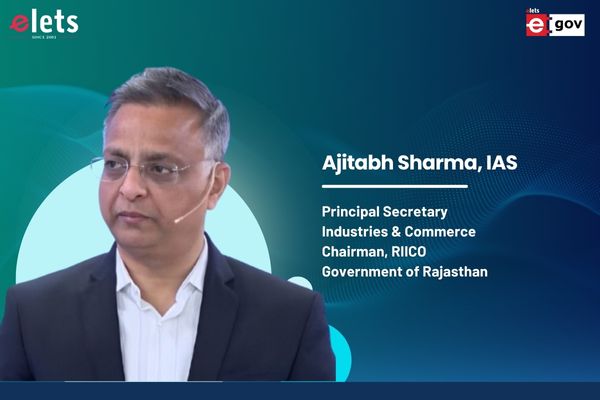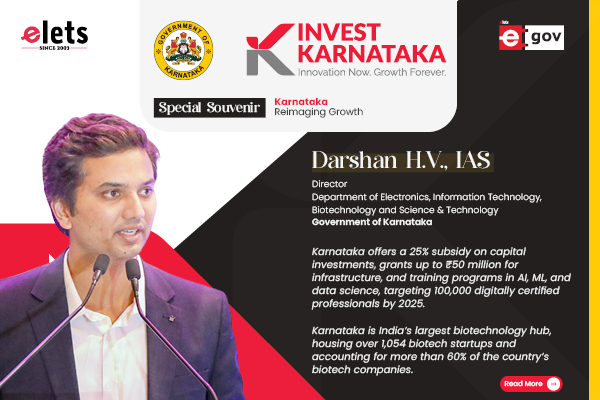 Ashis Sanyal, many a times called as ‘The SWAN-man of India’, started his professional career as an Engineer in the Ministry of Communications through Indian Engineering Services in 1975. Now, he is spearheading the SWAN implementation in the country with passion and determination.
Ashis Sanyal, many a times called as ‘The SWAN-man of India’, started his professional career as an Engineer in the Ministry of Communications through Indian Engineering Services in 1975. Now, he is spearheading the SWAN implementation in the country with passion and determination.
What is the vision and goal behind the State Wide Area Network (SWAN), one of the three core components of the NeGP? How will SWAN act as a vehicle to bring about improvement in the internal government processes, for increasing the efficiency, for automating relevant office workflow processes etc?

I may contemplate the vision of SWAN in a comprehensive statement: `State or the union territory (UT) should be provided with a state-of-the-art middleware, in the form of a seamless converged communication network, capable of transmitting voice, video and data in a secure seamless manner, connecting all the administrative and executive entities and field formations, which will enhance its administrative capabilities to serve the citizens in most effective way’. Therefore, the goal of SWAN is to establish a secure closed user group (CUG) communication network which would be scalable and would be having adequate capacity to run the converged network traffic between all government offices across the State or the UT. There would be a three or four tier architecture in which administration headquarters in the capital cities would be connected upto block level though the Telecom Service Providers’ existing backbone. Please note that in the SWAN Scheme, we have not envisaged laying of any new medium for connectivity wherever TSP backbone is available. Of course, in some difficult terrain in North-East or in Chhatisgarh, Madhya Pradesh, Jammu and Kashmir etc., there are some proposals to use V-SAT connectivity as TSP backbone in those places is either not available or ineffective. In all, approximately 7400 Points-of-Presence (PoP) would be created. These points of presence would be the aggregation points of all departmental offices near or around them.

Once fully operational, SWAN will be the riding horse for all internal government application packages meant for government work flow process and also for citizen-centric services. Service delivery packages will ride on SWAN and would be ultimately delivered through CSCs till all citizen-centric services become web-enabled. Every State /UT has listed out the current and future applications which it intends to run on the SWAN. It is expected that these would be bring in significant improvement in the efficiency with government functions. I understand regular video-conferencing with the district collectors has already made decision-making faster and cost effective.

What is the strategy adopted to fulfill the envisioned goal?

As you are aware, for implementation of the DIT initiatives under NeGP, it has been decided to adopt a model of ‘Centralised Initiative and de-Centralised Implementation’. I guess that other MMPs, being implemented by other line-departments, may also follow the same model. For SWAN implementation also we have followed this model very meticulously. At the first instance, we had issued the SWAN Guidelines in October 2004 after extensive consultations with the States and also with the National Informatics Centre (NIC). The Guidelines outlined all necessary bedrock features of the SWAN implementation. The primary motto of the Guidelines was to reflect a ‘sense of ownership’ of the SWAN project for the State or UT. Then we had standardised various document formats like, the format for tendering document i.e. (RFP), contract agreement between the State / UT and the SWAN Operator, bidding process, process for evaluation of the bids etc. The process for evaluation of the project proposal and centralised process of monitoring had been embedded in the Cabinet Note itself, which was approved by the Government. For this purpose, we have the Empowered Committee with Secretary, DIT in Chair, approved by the Government at the Central level for considering and approving the individual project proposal from State / UT. Further, in DIT, a SWAN team was created which is being assisted by a Programme Management Unit (PMU), which is named as SWAN Programme Management Consultant (SPMC) team. To deal with all relevant aspects of bandwidth provisioning for SWANs, one inter-departmental Working Group is in place, which is chaired by the Additional Secretary in the Department of IT. These are the people at the Central level who are managing the SWAN programme. At the State / UT level, another Empowered Committee is created, chaired by mostly the IT-Secretary In-charge, which takes care of every decision for de-centralised implementation at that level. The bidding process, decision on Third Party Agency, implementation details etc. all are decided by this State level Empowered Committee. Thus, a great sense of ownership is developed for this project at the State / UT level. I suppose this is very important for a project of such magnitude and complexity. We have been experiencing all good results from this strategy adopted by DIT.
Please also tell us about the plan to seamlessly integrate SWAN with other future e-Government infrastructures like state data centre, common service centres.
Technologically, the process for seamlessly connecting the other infrastructure like SDC or CSC would be simple. At the state headquarters PoP provision has been kept to have a peer-to-peer connectivity with the State Data Centre, Disaster Recovery Centre, NICNET, Internet Gateway etc. This is easily possible by keeping additional ports at the router level. This has been done at the level of design of network itself. For CSCs, you will recall that CSCs would be established below block level. So long the State or the UT wants the Service Centre Agency (SCA) of the CSC Scheme to use the SWAN to access the G2C services, applications or data, a provision can be made according to the need. Some States, like Assam, have even provisioned some incentive for the SCA to use the SWAN for such purposes. But in the long run I suppose, most of the G2C services will be web-enabled and with the standard broadband access procedures the CSC operator can use its broadband connectivity to access the web-enabled servers hosting the applications and data for G2C services. We have kept this future scenario in view and with the support from department of telecommunications (DoT) and Universal Services Obligations Fund (USOF) Administration already made an action plan for broadband connectivity to the CSCs across the country.
In March 2005, Department of IT obtained Government of India’s approval for the State Wide Area Networks (SWAN) Scheme for an overall outlay of INR 33,340 million, to be expended in five years. The SWAN Scheme would establish Wide Area Converged Networks in 29 States and 6 union territories (UT) across the country, from each State/UT headquarters to the blocks, creating more than 7000 Points-of-Presence (PoP) and connecting more than one million route kilometer of backbone and last mile. Implementation of this scheme is in full swing with individual project proposals have already been approved for 32 States/UTs .
Wide Area Networks being established in the States/UTs under the SWAN Scheme would serve a long way to provide G2G and G2C services involving voice, video and data, in the entire e-Governance eco system, especially for the various mission mode projects contemplated under the National e-Governance Plan (NeGP).
What are the business opportunities in implementing SWAN? How keen are the private sector to participate in the implementation of SWAN?
 As you know, the Option-I for implementation of SWANs calls for a PPP model. Most of the States have gone for a buildown– operate–transfer (BOOT) model for implementation. The payment from the Government would be in the form of Quarterly Guaranteed Revenue (QGR) for fi ve years i.e., 20 quarters in all. SWAN is a multi- stakeholder project and the implementation model suggests protection of business interest for every stakeholder. If the agreement between the Network Operator and the State or UT is worked out carefully keeping that in view and is followed in letter and spirit, the payment to the Network Operator is guaranteed. So there is a clear business opportunity in this green fi eld area. I understand that by going through the process of implementing the SWAN and operating it in a State for fi ve years, the Operator would get to know the State’s e-Government requirements more closely because being the Network Operator they would be present almost in all State offi ces. I suppose that from this angle, most of the prospective bidders have seen great business opportunities in the whole Scheme and they have shown signifi cant keenness in bidding for the RFPs. As on date, out of eleven states in which the network operators are in place, we have already eight number of System Integrators and Operators.
As you know, the Option-I for implementation of SWANs calls for a PPP model. Most of the States have gone for a buildown– operate–transfer (BOOT) model for implementation. The payment from the Government would be in the form of Quarterly Guaranteed Revenue (QGR) for fi ve years i.e., 20 quarters in all. SWAN is a multi- stakeholder project and the implementation model suggests protection of business interest for every stakeholder. If the agreement between the Network Operator and the State or UT is worked out carefully keeping that in view and is followed in letter and spirit, the payment to the Network Operator is guaranteed. So there is a clear business opportunity in this green fi eld area. I understand that by going through the process of implementing the SWAN and operating it in a State for fi ve years, the Operator would get to know the State’s e-Government requirements more closely because being the Network Operator they would be present almost in all State offi ces. I suppose that from this angle, most of the prospective bidders have seen great business opportunities in the whole Scheme and they have shown signifi cant keenness in bidding for the RFPs. As on date, out of eleven states in which the network operators are in place, we have already eight number of System Integrators and Operators.
From DIT side also, we feel that we are here to create a pro-competitive echo system for the prospective System Integrators and Network Operators in the country. As we move forward towards automation and automated service delivery at all levels in the government and in private sector, converged communication networks are here to stay and the size can only grow. I suppose, SWAN is only a beginning and any initial starter will always immensely gain, business wise, from the SWAN experience.
What is the current status of implementation of SWAN?
The SWAN Scheme was approved for the entire country i.e. for 29 States and 6 Union Territories. The state of Goa and the UT of Andaman and Nicobar Islands did not participate in the Scheme. We post the monthly progress of SWAN implementation in the DIT offi cial website www.mit.gov.in regularly for the last one and a half year. You may see in that progress report that out of 33 States and UTs, till date individual SWAN proposals have been considered and approved by the Empowered Committee for 28 States / UTs. Out of these 28 States / UTs, 7 States / UTs are implementing with Option-II i.e., NIC as the Implementing Agency, rest are going through a bid process to identify the Network Operator. In 19 States / Uts, implementation is at various levels and in 6 of them viz., Jharkhand, Haryana, Tamil Nadu, Kerala and Himachal Pradesh, NCT of Delhi and UTs of Tripura, Chandigarh implementation is at advanced stage.
What are some of the challenges (technological issues and policy issues) that need to be overcome to make SWAN as part and parcel of the government functioning?
There are few technological issues and challenges which are faced by the State / UT during the proposal and RFP preparation. These are mainly related to the requirement analysis in terms of the network capability. Interoperability between various network components progressively to be added over the project period, scalability of the network for the same purpose, various security measures to be taken to make the CUG network free from hacking and similar incidents, technology obsolescence cycle etc. are some key technological decisions to be taken by the State / UT during the project implementation. There are other related issues like training of the people working in all the departmental offi ces, backend automation requiring digitisation of huge government data also require important technical decisions to be taken at the administrative level. Inter-related to all these, there are many policy issues which also should be overcome for successful implementation and use of SWANs at the State/ UT level. One signifi cant issue is the essential reforms to take place in government business processes. These are required to derive the true benefi t of e-Governance per say. To make the SWAN effective, many services can be delivered either from the SWAN PoPs or from the departmental offi ce nodes connected to SWAN. This may require signifi cant changes in the business processes and there also may be some legal requirements. All these have to be done in order to make the network fully effective.
What is the awareness generation plan across all the government departments regarding extensive usage of SWAN?
There is an NeGP Programme Management Unit (PMU) housed in the Department of IT which, assists DIT in its coordination service to the Apex Committee with Cabinet Secretary in the Chair, for NeGP implementation. In this NeGP PMU there is a team, which takes care of the awareness and communications-related activities for the NeGP. Through this team we had conducted several state level workshops for generating awareness among the government decision makers, head of departments, In-charge of the fi eld formation units regarding the SWAN and CSC Scheme. We have achieved signifi cant success in these Workshops. In my opinion, capacity building is required back-to-back with the awareness generation. There is an extensive plan for this and a National Scheme is under consideration and approval. When this Scheme is approved, there would be specifi c organisational structure in place at the State / UT level which, would take this awareness generation, capacity building etc., activities forward to make the NeGP schemes successful. I also feel that change of mindset is utmost important in this regard. A change in the mindset would make one easily receptive to any awareness generation process. At present all these related processes are going parallel and results would defi nitely show up in next 2-3 years.
What are the key lessons from SWAN implementation? Any mid-term corrections? How has the SWAN concept changed from conceptualisation stage to implementation?
This is an important question to fi nish the interview. We really had several important lessons from the implementation process undertaken by the Department for the SWAN Scheme. At the fi rst instance, the SWAN has taken a serviceoriented approach. This calls for a paradigm shift in the whole approach for the States/UTs concerned, from procurement of equipment and systems to procurement of services against a defi ned service level agreement. You can take this is more or less a new approach for the governmental set up which has been procuring huge inventory / assets at all levels over decades. The service-oriented approach and making its processes well defi ned, have its own challenges and pitfalls.
I think, while preparing the RFP or the Contract Agreement for the Network Operator, each and every State / UT opted for Option-I, have gone through this experience. From DIT side we have also learnt the utility of standard templates for proposals, RFP and other related documents in terms of a centralised initiative for such pan-India Scheme. This decision of standardising the documents paved the way for better management of subsequent implementation processes at various levels.
Further, we appreciated the constraints currently exist in the country in skills / experience, to establish an optimal network design in a service oriented approach. There are many challenges here. For example, how to establish a plan in the BOOT model RFP for progressive induction of additional equipment in the network? How to integrate this requirement in a business model meant for 5 years etc.? We also felt the necessity of an institutional mechanism at every stakeholder level, for leveraging on cross learnings between different States / UTs.
Also, the original time estimates for different processes have gone wrong in some of the cases because most of the state related processes have taken more time than originally estimated. However, we did not have to make any signifi cant on-course corrections in the basic ground rules, defi ned in the SWAN Guidelines issued in October 2004. To that extent, there has been almost no change in the SWAN Scheme from the conceptualisation to actual implementation stage.
Be a part of Elets Collaborative Initiatives. Join Us for Upcoming Events and explore business opportunities. Like us on Facebook , connect with us on LinkedIn and follow us on Twitter, Instagram.
"Exciting news! Elets technomedia is now on WhatsApp Channels Subscribe today by clicking the link and stay updated with the latest insights!" Click here!













